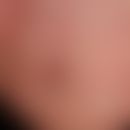Synonym(s)
DefinitionThis section has been translated automatically.
Chronic form of infant eczema which, in contrast to seborrhoeic eczema in childhood, does not manifest itself before the 3rd month of life.
EtiopathogenesisThis section has been translated automatically.
Various factors are discussed, including nutritional disturbances/allergies (cow's milk, egg, acidic foods, tomatoes), dysfunction of the sebaceous glands, infections caused by Malassezia species. Real food allergies, however, are only found in about 1/3 of infants.
You might also be interested in
ManifestationThis section has been translated automatically.
In the 1st year of life, not before the 3rd month of life.
LocalizationThis section has been translated automatically.
Onset on cheeks, then capillitium, neck, extremities (extensor rather than flexor), possibly entire body surface.
Clinical featuresThis section has been translated automatically.
Dermatitis with varying degrees of severity, chronic persistence or recurrence, which can range from mild sebostasis to diffuse erythema and extensive inflammatory foci of the skin.
In addition to diffuse scaly erythema, small papules, papulovesicles or scaly plaques are formed. This is always accompanied by varying degrees of itching, which is often excruciating and does not allow the infants (and their parents) to rest. A transition to weeping, later encrusted eczema plaques is possible.
Often secondary bacterial infections, especially in weeping areas.
On the capillitium areal adherent scale deposits possible, which may cover the entire area of the hairy head evenly. The comparison to burnt milk led to the term crusta lactea or milk crust.
The maximum variant is the infant's erythrodermal atopic eczema (S.a. Eczema atopic erythrodermal).
The diaper area typically remains free, even in the case of a pronounced and extensive eczema reaction (important diagnostic sign).
TherapyThis section has been translated automatically.
Avoid possible triggering allergens, e.g. milk protein, contact with animal epithelia. Wear air-permeable clothing (preferably cotton). Symptomatic external therapy with caring external agents such as Ungt. emulsif. aq., 2-5% urea cream/lotio (Eucerin 3% urea lotion, R102 ), Penaten oil, 5% dexpanthenol cream (e.g. Bepanthen cream, R064 ), bathing in oil baths (e.g. Balneum Hermal), avoiding irritation and occlusion.
Progression/forecastThis section has been translated automatically.
Healing, but also transition to atopic eczema in adults possible.
Incoming links (7)
Crusta lactea; Dexpanthenol cream hydrophilic 5% (nrf 11.28.); Diaper dermatitis; Eczema infant eczema constitutional; Leiner's disease; Milk crust; Urea cream hydrophilic 5 or 10% (nrf 11.71.);Outgoing links (7)
Atopic dermatitis (overview); Atopic erythrodermal dermatitis; Crusta lactea; Dexpanthenol cream hydrophilic 5% (nrf 11.28.); Papel; Pruritus; Urea cream hydrophilic 5 or 10% (nrf 11.71.);Disclaimer
Please ask your physician for a reliable diagnosis. This website is only meant as a reference.















